-
收藏模板
- 模板信息
- 更新时间:2023-09-22
- 字数:约17779字
- 页数:约10页
- 格式:.doc
- 推荐版本:Office2016及以上版本
- 售价:5 金币
您可能喜欢的文档
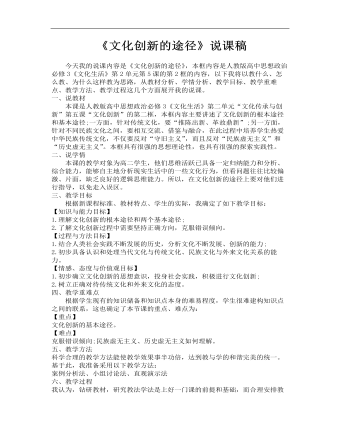
高中思想政治人教版必修三《文化创新的途径》说课稿
二、说学情本课的教学对象为高二学生,他们思维活跃已具备一定归纳能力和分析、综合能力,能够自主地分析现实生活中的一些文化行为,但看问题往往比较偏激、片面,缺乏良好的逻辑思维能力。所以,在文化创新的途径上要对他们进行指导,以免走入误区。三、教学目标根据新课程标准、教材特点、学生的实际,我确定了如下教学目标:【知识与能力目标】1.理解文化创新的根本途径和两个基本途径;2.了解文化创新过程中需要坚持正确方向,克服错误倾向。
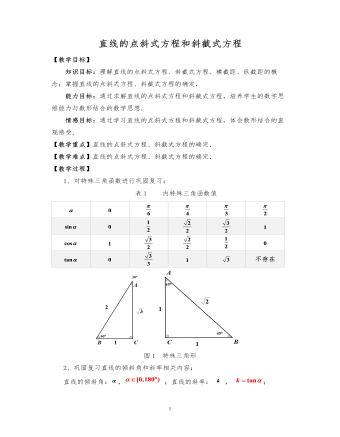
高中数学人教版必修二直线的点斜式方程教案
【教学重点】直线的点斜式方程、斜截式方程的确定.【教学难点】直线的点斜式方程、斜截式方程的确定.【教学过程】1、对特殊三角函数进行巩固复习;表1 内特殊三角函数值 不存在图1 特殊三角形2、巩固复习直线的倾斜角和斜率相关内容;直线的倾斜角:,;直线的斜率: , ;设点为直线l上的任意两点,当时,
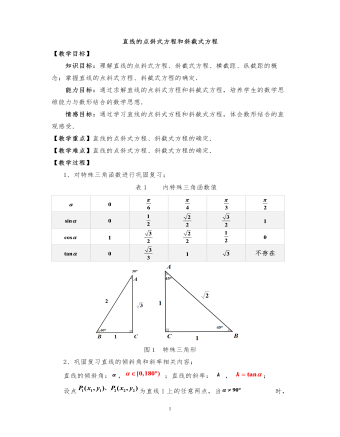
高中数学人教版必修二直线的点斜式方程教案
【教学目标】知识目标:理解直线的点斜式方程、斜截式方程、横截距、纵截距的概念;掌握直线的点斜式方程、斜截式方程的确定.能力目标:通过求解直线的点斜式方程和斜截式方程,培养学生的数学思维能力与数形结合的数学思想.情感目标:通过学习直线的点斜式方程和斜截式方程,体会数形结合的直观感受.【教学重点】直线的点斜式方程、斜截式方程的确定.【教学难点】直线的点斜式方程、斜截式方程的确定.
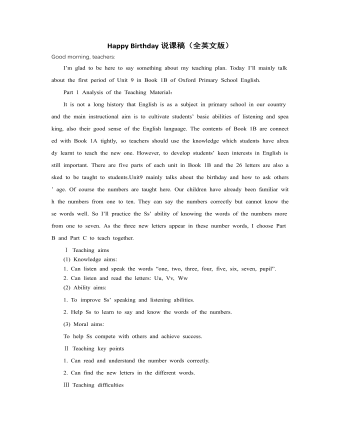
人教版新课标PEP小学英语三年级上册Happy Birthday(全英文版)说课稿
1. Do some exercise on the paper. There are four kinds of exercise here. The exercise 1 is to develop Ss’ ability of listening. Exercise 2 is to practice Ss’ ability of knowing the words. Exercise 3 is to develop Ss’ ability of speaking numbers and letters. Exercise 4 is to make Ss know the words and letters well. These exercises can consolidate the new knowledge from different styles of problems.2. Then tell Ss that we can sing the numbers like “ Do, re, mi, fa, so, la, ti, do” and let them listen to a song named “Do, Re, Mi”. Add some extra knowledge so that Ss will be glad to see that the numbers can be used in another way.Step 4 Homework1.Read the numbers from 1 to 7 and 7 to 1 five times.2.Read the letters “u, v, w” five times follow the tape.Reading is a useful way for the Ss of Grade One to practice the knowledge. Ask Ss to imitate reading from the tape in order to make Ss have a good habit of listening and let them have a better pronunciation.Step 5 Board writingI ‘ll put the seven numbers like a scale(音阶)as I’ll let Ss know that we can sing out the numbers. When it comes to listen to the song, I ‘ll draw a musical note on Bb. Unit 9 Happy birthday!sevensixfivefourthree U u V v W wtwo pupil five windowoneThat’s all for my class designing. Thank you for listening!
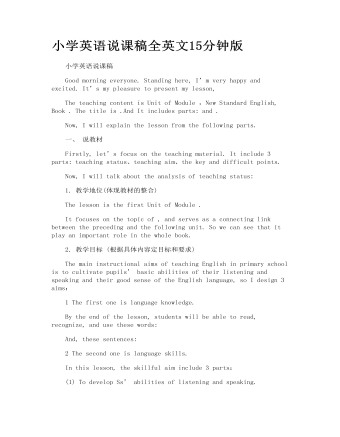
小学英语说课稿全英文15分钟版
一、 说教材 Firstly, let’s focus on theteaching material. It include 3 parts: teaching status、teachingaim、the key and difficult points. Now, I will talk about the analysis of teaching status: 1. 教学地位(体现教材的整合) The lesson is the first Unit of Module . It focuses on the topic of , and serves as a connectinglink between the preceding and the following unit. So we can see that it playan important role in the whole book. 2. 教学目标 (根据具体内容定目标和要求) The main instructional aims of teaching English inprimary school is to cultivate pupils’ basic abilitiesof their listening and speaking and their good sense of the English language,so I design 3 aims:
- 查看更多相关Word文档
Great scientists说课稿4篇
必修5unit 1说课稿一
1. Great scientists-John Snow Defeats “King Cholera”
Distinguished judges, good morning! I’m NO.2; it’s my great honor to be ’s Book5. And my content consists of 6parts, they are: analysis of the teaching material, analysis of the students,teaching and study methods, the teaching procedures, the blackboard design, andself-assessment. 1. This lesson is a reading passage, which plays a veryimportant role in this unit, we should lay particular emphasis on the students’ reading ability.

It focuses on thestudents’abilities to gather information; deal with information; solve problems and theabilities to think and express in English. By studying At the same time, weshould get the students to understand some difficult sentences to comprehendthe passage better. The students will do some listening, speaking, reading andwriting, too.
2. Now I’ll talk about my teaching aims of thisperiod.
According to the new curriculum standard,the teaching aims are divided into 3 parts:
①Knowledge aims: are to enable the studentsto master some useful
②Ability aims: are to develop the studentsreading ability and let them ③Emotional aims: are to develop students’ interest in study and set up 3. In theteaching process, teacher should help students master the important points andbreak through the difficult points as follows:
①Teaching important point: is to improvethe students’reading ability. ②Teachingdifficult points: are to help Ss understand the text better and use the learnedphrases to retell the text.
The Ss in my class have known somethingabout the topic, because they have talked about it in the previous period. Butsome long sentences are difficult for them to understand. They don’t often use English to express themselvesand communicate with others. Some students are not active in class because someare afraid of making mistakes while speaking. So during the lesson, I’ll arrange a variety of activities to letall the students join in class to attract their attention and make themconfident. Teaching methods includes:
Task-based approach, communicativelanguage teaching and interactive approach.
Study methods:
And I will adopt cooperative learning;communicative learning; and participative learning methods.
I’ll make full use of modern equipment suchas the multi-media to make my lesson more lively and interesting. With the aidof the computer, I think the
efficiency of the lesson will be greatlyimproved.
Ⅳ. Here comes the most important part, theteaching procedures:
I have designed the following steps totrain the students’ability of listening, speaking, reading and writing, especially readingability.
Step1. Lead-in
Through this activity I can arouse thestudents’interest of study and bring in new subject.
Step2. While-reading
Task1: Guessing and skimming
I’ll get the students to look at the titleand the pictures and guess what the text might be about. It draws the students’ attention to the content of the text.
Ask the students to read the passage asquickly as they can and get the structure of the text. Guide the students tofind out key words and sentences or pay attention to the first sentences ofeach paragraph to get the main idea of the text.
By doing this, I will train the students’ fast reading skills to improve thestudents’reading ability and let the students understand the general idea of eachparagraph.
Task2: Intensive reading
The students are required to focus on thewhole text paragraph by paragraph to locate particular information and finishthe exercises on the screen.
These exercises are mainly sentencejudgments, choices about the text. They are designed from the easiest one tothe most difficult one for different levels’ Ss. The purpose is to train the students’ skills of scanning and to lead thestudents to find out the important facts and detailed information.
I’ll ask the students to finish theexercises by cooperation and competition. They are divided into 4 groups. If astudent can answer the question correctly, then the group can get one point.And the group which gets the most points is the winner. Only throughcooperation can the Ss taste the joy of success. If the Ss know their answer isright, they will be confident and become more enthusiastic in learning English.The purpose is to improve the students’ reading comprehension. And at the sametime the students can become aware of the happiness of helping each other. Thusthe students receive some moral education.
Step3. Post-reading
Task2: Listening
Play the tape of the passage for thestudents to listen and follow. Then ask them to read the text aloud. Tell themto pay attention to the pronunciation and intonation. At the same time, theycan enjoy the beauty of the English language. And it can prepare the studentsfor the retelling the text in the next task.
Task3: Summary and retelling
I will let them fill in the blank tosummarize the general idea of the text. And then ask the students to retell thestory in their own words. This is designed to apply what they have learnt intopractice, thus transforms the language knowledge into ability by using English.
Ⅴ.Blackboard design
The title is on the top of the blackboard.The blackboard is divided into 2 parts: the left part is for some key words andexpressions, while the right part is for the screen.
Ⅵ.
In this lesson, I lead the studentsunderstand the passage step by step, and help them to retell the text. In thewhole period I just act as a director, put Ss into center, giving the studentssome detailed task and letting the students explore the knowledge by themselvesor in teamwork. But there are some new
language points in the passage, so I willexplain them for the students next period.
Thank you for listening.
必修5unit1说课稿二
Book5unit1Great scientists说课稿
教材分析
本单元主要话题是Great scientists, 旨在通过本单元的教学培养学生探究科学、崇尚科学的精神和正确的科学观;帮助学生了解科学的本质和科学家的特质。由于是科普文章,相对来说比较枯燥,所以我们需要把教材内容简化并进行重组。根据“三课型一学案”的原则,我们将Warming Up,Pre-reading, Reading和Comprehending三部分整合为一节“阅读课”。今天我主要就对这一部分进行简要的阐述。
教学重难点:
阅读能力对英语学习者来说是至关重要的,所以本节课的教学重点就是让学生学会不同的阅读技巧并且让学生通过本节的学习了解John Snow 是怎样战胜“霍乱”这种疾病的;难点是让学生能自己描述伟大的科学家及其相关事迹。
教学目标:
1. 知识目标:使学生了解一些著名的科学家及他们的主要贡献并通过阅读知道John Snow 是怎样战胜“霍乱”的。
2. 能力目标:培养学生不同的阅读技巧并使他们能介绍一些伟大的科学家。
3. 情感目标:激发学生尊重热爱伟大的科学家,学习他们的高尚道德品质。
教学过程分析:
根据教学目标以及教学重难点,我们把这节课分为七个步骤。
一、导入
通过大屏幕给学生展示一些伟大科学家的图片,比如牛顿、霍金、爱因斯坦、钱学森等,让学生通过讨论了解他们的主要贡献以及他们的优秀品质。通过这一环节自然而然的就过度到本单元的话题Great scientist.
二、热身
让学生两个人一组通过讨论来完成课本第一页的小测试,比比哪一组知道的多,这样可以极大提高学生的兴趣,让他们每个人都积极参与到课堂活动中来。
三、读前
在大屏幕上呈现两个问题。通过回答这两个问题可以使学生对课文有一个初步的了解和预测,这有助于发散学生的思维,也很好地为下一个环节做了铺垫。
四、阅读
1. 通过略读(skimming)让学生找出文章的大意。
2. 在大屏幕上展示五道涉及文章细节的选择题,通过查读(scanning)让学生找出这五道题的答案。
3. 给学生展示三个任务,一是填写表格,二是回答问题,三是填空来训练学生细读(careful reading)的能力。
这一环节主要使用任务型教学法,旨在通过多种不同类型的练习从不同的层面训练学生略读、查读、细读等阅读技巧。
五、巩固
老师在黑板上写一些关键词,让学生复述课文。每个学生只说一句话,这样我们可以激发学生的兴趣,让更多的学生参与到课堂活动中。
六、讨论。
给出问题:近些年一直存在着像“非典”、“艾滋”、“猪流感”等各种各样的传染病,作为一名学生我们可以做些什么?
让学生四个人一组讨论,在时间允许的情况下找尽可能多的学生到讲台上阐述自己的观点。这个环节的设计有助于培养学生的情感态度与价值观。
七、作业
重读课文,写一篇关于John Snow 如何战胜“霍乱”的文章。
最后,我想说一下我的这节课是怎样体现新课改的理念的。前两个环节的设计激发了学生的学习兴趣。新课改提倡的“任务型教学法”在这节课中多次用到。小组讨论等形式充分体现了“自主、合作、探究”的精神,把更多的时间还给学生。另外,讨论环节在一定程度上培养了学生的情感态度和价值观。因此,通过这节课的学习,学生不仅能学到该掌握的知识,训练了他们的阅读技能,更重要的是,他们可以体会到学习的乐趣
必修5unit1说课稿三
Good afternoon, distinguished judges. It’s my great honor and pleasure to be heresharing my lesson with you.
I am ready to begin this representationwith five parts: analysis of the teaching material, the teaching methods, thestudying methods, the teaching procedure and blackboard design.
Now, I’m going to talk about the teachingmaterial.
First of all, the content of my lesson isNew Senior English for China Student’s Book 5, Unit 1. This unit is about greatscientists. Through the study of this unit, I’m going to help students learn more aboutgreat scientists and develop their interest in scientific research. At the sametime, I will enable the students to learn how to use the past participle. Inthis lesson, it starts with pre-reading and reading. (As we all know, readingis a kind of input during the process of language learning, which has greateffect on output, such as speaking and writing.) Therefore, it plays animportant role in the English teaching of this unit. If the Ss can master itwell, it will be helpful for them to learn the rest of this unit.
Secondly, according to the new standardcurriculum and the syllabus (新课程标准和教学大纲), and after studying the teachingmaterial, I summarize the teaching aims as follows:
1. Knowledge objects
(1)The Ss can master the usage of theimportant words and expressions, such as defeat, attend, expose, cure, outbreak,control, absorb, severe, put forward, etc.
(2)The Ss can use the past participle inthe proper situation.
(3)The Ss can understand the content ofthe lesson, talk about science and get their own idea about what are the commoncharacteristics of scientists.
2. Ability objects
(1) To develop the Ss’ abilities of listening, speaking, readingand writing
(2) Focus on improving the student’s reading ability, especially theirskimming and scanning ability. (3) To train the Ss’ abilities of studying by themselves andcooperating.
3. Emotion or moral objects
(1) By completing the task, the Ssincrease their interest in science and respect for scientists.
Thirdly, what are the important anddifficult points of this unite? I think the important point is the usage ofpast participle. And students may find it difficult to narrate under giventopic using the words and sentences that they have learned.
Well, how to achieve the teaching objectsmentioned above? How to stress the important points and break through the difficultpoints? According to the analysis of the teaching material and the students’ learning background, I will use thefollowing methods.
1. Communicative Approach(交际教学法)
2. Task-based Language Teaching (任务教学法)
3. Situational Language Teaching (情景教学)
That is to say, I’ll let the Ss to get a betterunderstanding of the key structure of the text through discussion. According tothe modern social communication teaching theories (现代社会交际教学理论),I adopt the Situational Language Teachingmethod and Task-Based Language Teaching method in my teaching.
Now, let’s move to the third part, StudyingMethods.
Students of this stage are quick inthought and they are eager to show what they know and they have a certainability to read. But they are lack of geography knowledge, the culturalbackground of those foreign countries and the courage to express their ideas.Therefore, a successful leader should care for their learning strategy. In thislesson, I will teach my students to master the following strategy:
1) Basic learning strategy
Students can get the meaning of the wordsand phrase.
2) Practice strategy
Practice can help students to get thegeneral idea and have a better understanding of the language.
3) Communication strategy
Help students to use what they learn indaily conversation and thus enhance the communication skills.
In a word, I will teach students apply “observation-imitation-practice” strategy to studying English and teachthem how to be successful language learners
Then we come to the most important part ofthe representation, Teaching Procedure.
In this lesson the students will be thelearner and the main participant. I will act as a guider, an organizer and adirector who plays a role when necessary in teaching procedure.
Step 1. Lead-in. (__8__min)
I think the most useful method to lead thestudents to learn is interest stimulating and discussion by themselves. At thebeginning, I will let the students watch a 66-second CNN report about Youyou Tuwinning the Nobel Prize. And then ask them to name some famous scientists theyknow and tell something about them. At the end of lead-in, I will ask them thequestions of warming-up part to see who knows the most.
Purpose of my design:
(1) To catch Ss’ attention about the topic.
(2) To set up suspense interest in greatscientists.
Step 2. Pre-reading
Task 1. (group work __5___min)
Divide students into several groups andask them to discuss the order of setting out a new scientific idea given in thefirst question of Pre-reading part.
Purpose of my design:
(1) to get the students know somethingabout how to prove a new idea in scientific research.
(2) To help students get a betterunderstanding about the importance of scientific research.
Step 3. Reading
Task 1. (Individual work___5__min)
Task 2. (Class work __12___min)
Listen to the tape finish the firstcomprehending exercise in our textbook--number the events in right order.
Purpose of my design:
1) Further familiarize the students withthe text;
2) Train students to find answers throughlistening
Task 3. (Individual work __15___min)
Guide Ss to read the material carefullyand take some important notes, then select students to read the paragraph oneby one, and ask them to find out the correct answers.
1.
2.
3.
4.
…
Purpose of my design:
Enable students to understand the givenmaterial better by using different reading skills. And proper competition(paragraph reading) can arouse the Ss’ interest in English learning. “Task-based” teaching method is used here to developthe Ss’ability of solving problems.
Step 4. Homework
1. Ask students to learn more informationabout cholera, for example, searching the internet, asking doctors, etc.
2. Ask students to choose one of theparagraphs and read it out loud for several time, the more fluently the better.
Purpose of my design: Homework is soimportant and necessary in encouraging students to keep learning after class.
Blackboard design
John Snow Defeats “King Cholera”
必修5unit1说课稿四
John Snow Defeats King Cholera说课稿
各位评委老师好。我说课的题目是高中英语必修5第一单元Great Scientists的阅读课内容。此内容为本单元的第一课时。我主要从教材分析、教法和学法、教学过程、板书设计这四个方面来分析本课。
I教材分析:
①教材简介:
在这节课,学生将学习Warming Up、Pre-reading、Reading。本单元主题是Great Scientists。本单元的话题是科学家如何以探索、钻研、无畏的科研精神验证未知的科学真理。Warming Up部分以问答比赛的形式进行,通过十组问题,引导学生回顾不同领域不同时代的10位科学家,了解他们对人类的贡献及其成果。Pre-reading部分通过对几个问题的讨论,让学生了解关于霍乱等传染病的常识,并初步了解得出科学观点所需要的基本程序,为完成阅读奠定基础。Reading部分介绍英国著名医生John Snow是如何通过考察、分析、探究的科学方法,发现并控制霍乱这种传染病的。
②教学目标:
根据教材内容和高中英语课程标准,我拟定下列教学目标:
A语言知识目标:使学生掌握重点词汇、短语和句型,进一步熟悉科学文化方面的话题 B语言技能目标:使学生能从文章中获取和处理主要信息
C情感态度目标:使学生保持学习英语的愿望与兴趣,主动参与有助于提高英语能力的活动
③教学重点:
因为本组教材的重点了解项目是John Snow破解霍乱难题,所以本课的教学重点是使学生了解John Snow是如何破解霍乱难题的。
④教学难点:
考虑到学生拓展阅读能力、语言输出能力等方面还需进一步努力,所以本课的教学难点确定为:如何使学生用恰当英语谈论、描述科学家以及他们的故事。
II教法和学法:
①教学方法:
引导学生独立思考、合作学习,进行师生、生生互动的任务型教学,设计了多个易于操作的任务型活动。
此课主要处理好教学的三个阶段:即Pre-reading、Reading、Post-reading。Pre-reading激活相关知识,预测文章内容,提高学生的学习兴趣。Reading主要通过各种阅读活动理解课文,获取必要的信息,完成问题。Post-reading主要是让学生结合所学知识,通过讨论、小组合作,发展与人沟通和与人合作的能力,提高学生收集信息、整理信息及传递信息的能力。
②学法:
任务型教学强调的是Learning by doing,学生通过完成教师设定的任务活动,激发学习兴趣,更有利于发挥学生的主体性作用,达到学习和掌握语言的目的。
③教具:
使用多媒体平台和直观道具,以扩大学生知识面和求知欲。
III教学过程:
Step 1 Warming Up and lead-in:
① I’d like to ask the Ss: What do you knowabout great scientists?
Then I’ll let the Ss try the quiz and find outwhich group knows the most.
通过竞赛游戏,开展小组间的比赛,激发学生了解不同领域不同时代科学家的兴趣和热情。
转载请注明出处!本文地址:
https://www.lfppt.com/worddetails_8889421.html最新说课稿文档
-
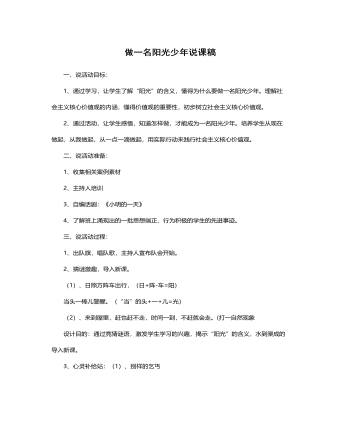
做一名阳光少年说课稿
1、紧密联系学生的生活实际,所选材料、所有活动均本着为主题服务的原则。2、形式多样化。通过心灵补给站、我来当编剧、心动不如行动等丰富多彩的活动,激发学生的热情,充分发挥他们的主体性。3、用生活中的真人真事激励他们,震撼他们的心灵,对学生进行教育,让他们得到感悟。五、说评价方式:要真正发挥主题队会的教育作用,千万不能把主题队会开成“检讨会”、“批评会”。兴趣是最好的老师,在课堂上,学生有了兴趣,才会有学习的动机,所以,在教学过程中,我努力把学生当作一个平等的朋友来对待,对于学生的回答进行评价时,本着“多表扬少批评,多鼓励少指责”的原则,尽量不用指令性、批评性的语言,最大限度的挖掘学生的优点,进行激烈性评价。

追思先烈魂,弘扬爱国情说课稿
环节四深入实践——弘扬爱国情爱国不是一句口号,要将爱国情怀落实到行动中去,队员们在各队队长的组织下,商讨出了落实方案。1、第一小队和第二小队组成了先烈故事演讲团,利用班会十分钟的时间,在三四年级宣讲先烈故事。2、第三小队和第四小队组成了创编小能手,编唱了爱国童谣、爱国拍手歌,告诉大家,爱国无处不在,爱国要从小事做起。3、第五小队和第六小队编写的爱国倡议书,提倡大家让爱国从口号落实到行动。4、全体队员共同宣誓:时刻准备着,为共产主义事业而奋斗,将活动推向了高潮。环节五大队辅导员总结“风雨沧桑,多遭铁蹄践踏,未有沉沦终奋起;荡涤污浊,重聚华夏精魂,披荆斩棘勇向前。”让我们牢记自己是中国人,怀一颗中国心,明确方向,努力奋斗,早日实现自己的梦想。
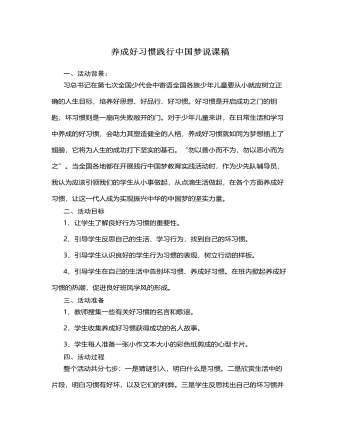
养成好习惯践行中国梦说课稿
第七步:全班学生一起倡读承诺书:(课件出示)我们都是小学生,培养习惯最要紧;上课应当专心听,积极开动小脑筋;作业认真仔细做,按时完成交得勤;有了错误要订正,知识才能学得清;人生要有好习惯,我们牢牢记心上。最后请学生把自己要养成的好习惯写在心意卡上,写好后粘贴在教室后面的园地里,互相督促,使得此次活动教育延续课后,直至影响一生.5、活动效果及反思此次活动开展后,学生们增强了对自身的认识,很多学生下决心改掉自身的坏习惯,并逐步采取了实际行动,从身边的小事做起,而且在学生中间还兴起了互相帮助、互相指正、争相进步的热潮。通过此次活动我也切实的体会到养成教育要开展就要落到实处,从实际出发,让学生亲自去感受,去体会,并且要持之以恒的做下去。同时作为老师更应该有一颗敏感热情的心,随时发现学生身上的闪光点与不足,多指正、多指点、多鼓励、多表扬,做到时时处处皆教育,这样才能赢得孩子,做好教育。
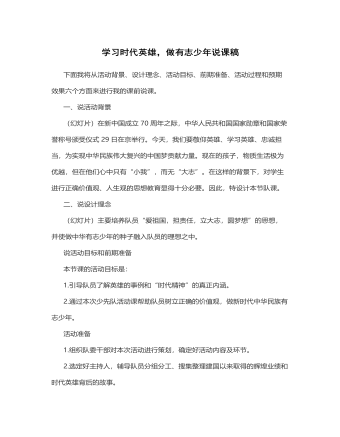
学习时代英雄,做有志少年说课稿
一、说活动背景(幻灯片)在新中国成立70周年之际,中华人民共和国国家勋章和国家荣誉称号颁受仪式29日在京举行。今天,我们要敬仰英雄、学习英雄、忠诚担当,为实现中华民族伟大复兴的中国梦贡献力量。现在的孩子,物质生活极为优越,但在他们心中只有“小我”,而无“大志”。在这样的背景下,对学生进行正确价值观、人生观的思想教育显得十分必要。因此,特设计本节队课。二、说设计理念(幻灯片)主要培养队员“爱祖国,担责任,立大志,圆梦想”的思想,并使做中华有志少年的种子融入队员的理想之中。说活动目标和前期准备本节课的活动目标是:1.引导队员了解英雄的事例和“时代精神”的真正内涵。2.通过本次少先队活动课帮助队员树立正确的价值观,做新时代中华民族有志少年。
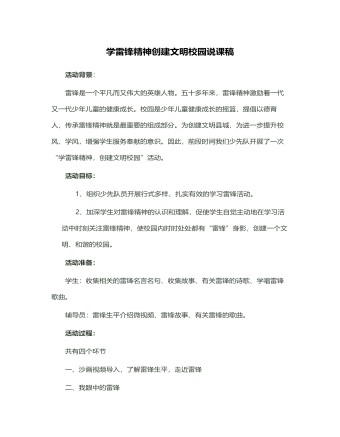
学雷锋精神,创建文明校园说课稿
雷锋精神是什么?这一环节是让学生用简单的词语或句子概括。通过这一活动,让学生概括出雷锋精神的内涵:像无私奉献、乐于助人、为人民服务、勤俭节约、尊老爱幼、勤奋好学、干一行爱一行、言行一致等等都是雷锋精神的体现。我们少年儿童是中国的未来和希望,雷锋精神的发扬和光大,创建文明校园的任务就落在他们的肩上,所以在这里我还设计了为发扬雷锋精神,创建文明校园“我该怎么做”这样的问题,目的就是让他们一起行动起来,学雷锋做好事,并制作了“荣誉”旗,奖励身边的好人好事。活动延伸:这里我设计了一个角色游戏活动——我要义卖献爱心,这个游戏学生们表现得非常积极,他们收集了自己不要的小文具或小玩具,将他们拿到集市上去卖,卖东西获得的钱,捐给王奶奶的孙女,因为王奶奶的孙女生病了,无钱治病。我觉得这个游戏使学生们懂得,一个人只要有爱心,只要愿意去帮助别人,无论什么方式都行,而且在游戏活动中孩子们体会到了帮助别人是一件多么多么快乐的事呀。
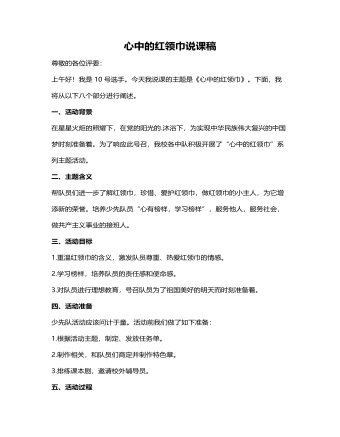
心中的红领巾说课稿
1.学习“最美红领巾”。图文结合,学习“美德少年”刘华婷、刘颖等人的先进事迹。2.记录“平凡红领巾”。展示队员们活动前精心准备的“随手拍”,发现普通队员在日常生活中的闪光点。3.填写“我为红领巾添光彩”心愿卡,对学生进行理想教育。4.齐唱《红领巾之歌》,点燃信念火种。5.辅导员对此次活动进行总结,并颁发特色章。(出示三个特色章图标)六、活动延伸红领巾精神需要代代相传,珍爱红领巾的意识需要时时提醒,本次活动后,我们会开展“小小新四军”、“鲜艳的红领巾”等后续活动,帮助队员们将红领巾精神永远铭记在心。七、引导要点四年级队员具备一定的活动能力和经验,通过课本剧的亲身体验、心愿卡的真情表达等多种方式的运用,引导队员热爱红领巾,以红领巾精神指引自己健康成长。八、活动评价本次活动,队员们受到了良好的教育。但是四年级队员自我约束能力不够强,缺乏持久性,萌生的意识和激情往往只停留在活动时,不能在活动后内化为自觉行为,这些问题有待探究。
今日更新Word
-
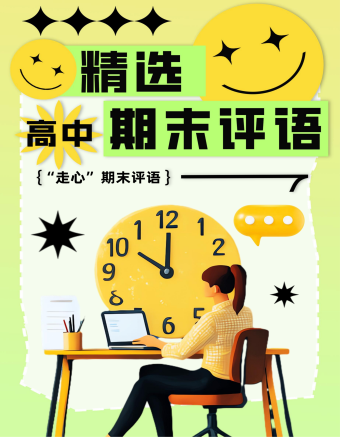
精选高中生期末评语
1、该生学习态度端正 ,能够积极配合老师 ,善于调动课堂气氛。 能够积极完成老师布置的任务。学习劲头足,听课又专注 ,做事更认 真 ,你是同学们学习的榜样。但是,成绩只代表昨天,并不能说明你 明天就一定也很优秀。所以,每个人都应该把成绩当作自己腾飞的起 点。2、 你不爱说话 ,但勤奋好学,诚实可爱;你做事踏实、认真、为 人忠厚 ,是一个品行端正、有上进心、有良好的道德修养的好学生。在学习上,积极、主动,能按时完成老师布置的作业,经过努力 ,各 科成绩都有明显进步,你有较强的思维能力和学习领悟力,学习也有 计划性,但在老师看来,你的潜力还没有完全发挥出来,学习上还要有持久的恒心和顽强的毅力。
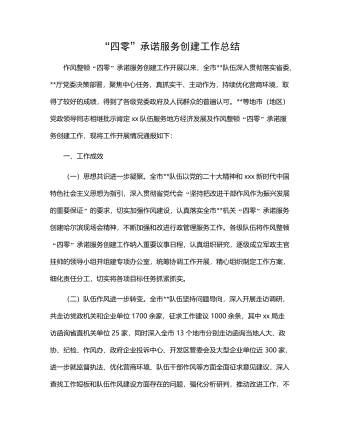
“四零”承诺服务创建工作总结
(二)坚持问题导向,持续改进工作。要继续在提高工作效率和服务质量上下功夫,积极学习借鉴其他部门及xx关于“四零”承诺服务创建工作的先进经验,同时主动查找并着力解决困扰企业和群众办事创业的难点问题。要进一步探索创新,继续优化工作流程,精简审批程序,缩短办事路径,压缩办理时限,深化政务公开,努力为企业当好“保姆”,为群众提供便利,不断适应新时代人民群众对政务服务的新需求。(三)深化内外宣传,树立良好形象。要深入挖掘并及时总结作风整顿“四零”承诺服务创建工作中形成的典型经验做法,进一步强化内部宣传与工作交流,推动全市创建工作质效整体提升。要面向社会和公众庄严承诺并积极践诺,主动接受监督,同时要依托电台、电视台、报纸及微信、微博等各类媒体大力宣传xx队伍作风整顿“四零”承诺服务创建工作成果,不断扩大社会知情面和群众知晓率。
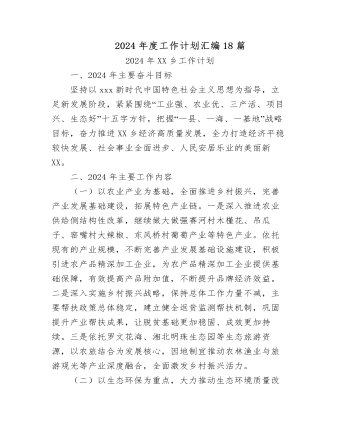
2024年度工作计划汇编(18篇)
1.市政基础设施项目5项,总建设里程2.13km,投资概算2.28亿元。其中,烔炀大道(涉铁)工程施工单位已进场,项目部基本建成,正在办理临时用地、用电及用水等相关工作;中铁佰和佰乐(巢湖)二期10KV外线工程已签订施工合同;黄麓镇健康路、纬四路新建工程均已完成清单初稿编制,亟需黄麓镇完成图审工作和健康路新建工程的前期证件办理;公安学院配套道路项目在黄麓镇完成围墙建设后即可进场施工。2.公益性建设项目6项,总建筑面积15.62万㎡,投资概算10.41亿元。其中,居巢区职业教育中心新建工程、巢湖市世纪新都小学扩建工程已完成施工、监理招标挂网,2月上旬完成全部招标工作;合肥职业技术学院大维修三期已完成招标工作,近期签订施工合同后组织进场施工;半汤疗养院净化和医用气体工程已完成招标工作;半汤疗养院智能化工程因投诉暂时中止;巢湖市中医院(中西医结合医院)新建工程正在按照既定计划推进,预计4月中下旬挂网招标。
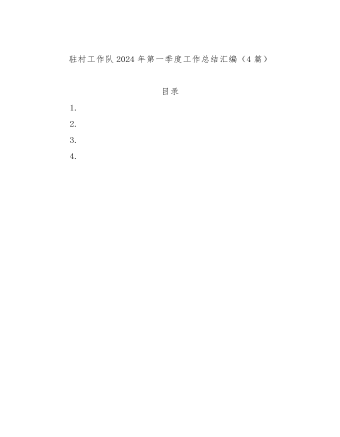
驻村工作队2024年第一季度工作总结汇编(4篇)
三是做大做强海产品自主品牌。工作队于xx年指导成立的冬松村海产品合作社,通过与消费帮扶平台合作,在工作队各派出单位、社会团体、个人支持下,已获得逾xx万元销售额。2022年底工作队推动合作社海产品加工点扩建的工作方案已获批,待资金下拨后将正式启动扩建工作。四是积极助企纾困,带动群众增收致富。工作队利用去年建立的xx镇产业发展工作群,收集本地企业在产品销售、技术、人力、资金、运营、用地等方面的需求,并加大xx支持乡村振兴力度,xx助理赴各村委开展多场xx政策支持乡村振兴宣讲活动,本季度有x万元助农贷款获批,xx万贷款正在审批中。在壮大既有产业的同时,完善联农带农机制,一方面鼓励企业雇用本地农户就业,另一方面计划与本地农户签订长期收购合同,让农民种得放心、种得安心,带动当地群众共同致富。

主题教育总结常用提纲大全
第一,主题教育是一次思想作风的深刻洗礼,初心传统进一步得到回归。第二,主题教育是一次沉疴积弊的集中清扫,突出问题进一步得到整治。第三,主题教育是一次强化为民服务的生动实践,赤子之情进一步得到提振。第四,主题教育是一次激发创业担当的有利契机,发展层次进一步得到提升。2.第一,必须提领思想、武装思想。第二,必须聚焦问题、由表及里。第三,必须领导带头、以上率下。第四,必须务实求实、认真较真。3.一是抬高政治站位,坚持大事大抓。二是坚持思想领先,狠抓学习教育。三是突出问题导向,深入整改纠治。四是坚持领导带头,发挥表率作用。4.一是立足“早”字抓筹划。二是着眼“活”字抓学习。三是围绕“统”字抓协调。5.一是形势所需。二是任务所系。三是职责所在。四是制度所定。6.一要提升认识。二要积极作为。三要密切协作。
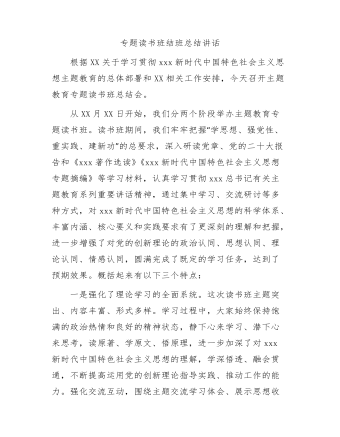
主题教育专题读书班结班总结讲话
第二,要把调查研究贯穿始终,实干担当促进发展。开展好“察实情、出实招”“破难题、促发展”“办实事、解民忧”专项行动,以强化理论学习指导发展实践,以深化调查研究推动解决发展难题。领导班子成员要每人牵头XX个课题开展调查研究,XX月底前召开调研成果交流会,集思广益研究对策措施。各部门、各单位要制定调研计划,通过座谈访谈、问卷调查、统计分析等方式开展调查研究,解决工作实际问题,帮助基层单位和客户解决实际困难。第三,要把检视问题贯穿始终,廉洁奉公树立新风。认真落实公司主题教育整改整治工作方案要求,坚持边学习、边对照、边检视、边整改,对标对表xxx新时代中国特色社会主义思想,深入查摆不足,系统梳理调查研究发现的问题、推动发展遇到的问题、群众反映强烈的问题,结合巡视巡察、审计和内外部监督检查发现的问题,形成问题清单。


















